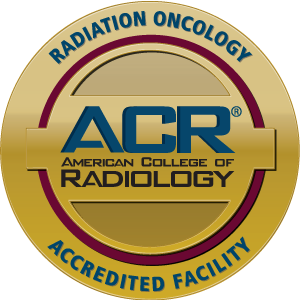As part of our comprehensive and multidisciplinary approach to cancer care, our radiation oncologists assess how radiotherapy may benefit each liver cancer patient.
Radiation therapy may be beneficial in situations where:
- Cancer cells are found in lymph nodes
- Cancer cells remain after surgery (called positive margins)
- Cancer within the liver cannot be removed with surgery
Radiation therapy uses high-energy X-rays to kill cancer cells. The radiation overwhelms cancer cells with oxidizing molecules that disrupt important cell functions and damage the DNA inside cancer cells, thereby killing them. Normal cells are better able to protect and detoxify themselves and are therefore more resistant to the radiation.
We offer patients with liver cancer the most advanced radiotherapy treatments, including:
External beam radiation therapy (EBRT)
This most common method of delivering radiation therapy is used in only some cases of liver cancer. The liver is particularly sensitive to radiation, and modest doses to the tumor can result in significant radiation to normal liver tissue.
Three-dimensional conformal radiation therapy (3D CRT)
This is a form of EBRT where a few shaped radiation beams are aimed at the cancer target from different directions.
Volumetric modulated arc therapy (VMAT)
A more precise form of EBRT than 3D CRT, the radiation dose and the field shape is changed, or modulated, as the treatment machine moves (or arcs) around the patient. This treatment helps to spare more normal tissue.
Stereotactic body radiation therapy (SBRT)
This is similar to VMAT in that it is planned with great precision, but the difference is that the entire radiation dose is given over fewer treatments (typically about five). Our radiation medicine team goes to great lengths to achieve the necessary precision to target the cancer but protect normal tissue and organs, such as a gating technique that holds the patient still and reduces movement from breathing.
Selective internal radiation therapy (SIRT)
In this therapy (also known as radioembolization), a catheter is inserted into the artery that leads to the liver tumor. Radioactive microbeads are released through the catheter and delivered directly to the tumor. The radiation dose is concentrated in the tumor, where the beads collect, and very little radiation reaches adjacent tissue. Using SIRT, higher radiation doses can be delivered with fewer side effects to nearby tissue and organs than with external beam radiotherapy. Radioembolization combines radiotherapy with embolization. This technique destroys the blood vessels that the tumor needs to grow and kills the cancer cells.
What sets us apart
All radiation therapy centers are not equal. Roswell Park’s Department of Radiation Medicine offers:
- Board-certified full-time multidisciplinary radiation faculty, including dosimetrists and medical physicists.
- Radiation oncologists who specialize in liver malignancies for which tumor and treatment definitions are critical.
- The latest, evidence-based, conformal radiotherapy techniques to treat liver and other hepatobiliary tumors.
- Radiation therapy that is planned and coordinated in concert with your on-site surgical and medical oncologists to provide the highest degree of comprehensive and fully integrated treatment.
